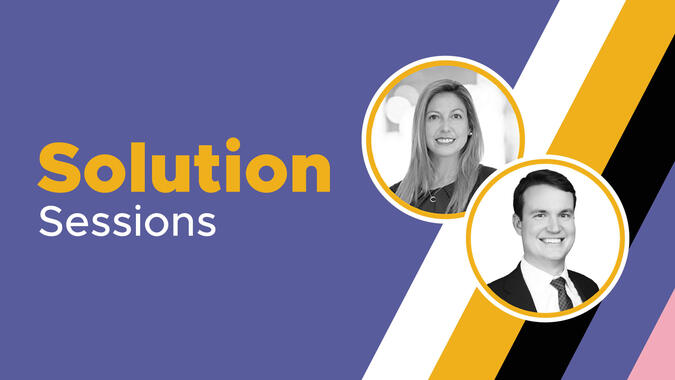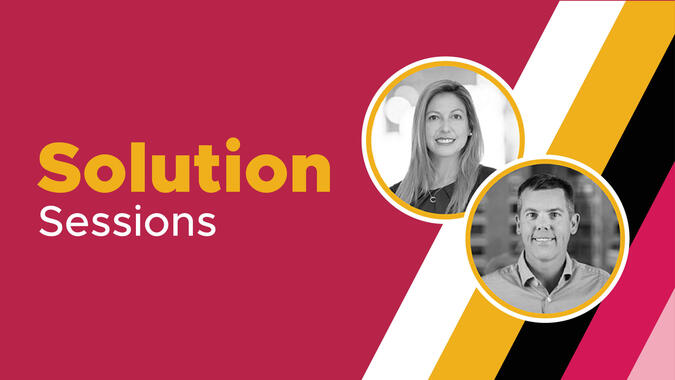
Interview with NYCON Chief Operating Officer Kelly Mathews
- Published
- Jan 23, 2020
- By
- Candice Meth
- Share
Candice Meth, National Leader for EisnerAmper’s Not-for-Profit Services Practice, sits down with Kelly Mathews, the COO for the New York Council of Nonprofits, for an in-depth discussion around best practices and recent observations with respect to not-for-profit governance.
Transcript
Candice Meth: Hello and welcome to EisnerAmper's podcast. I'm your host Candice Meth, national leader for EisnerAmper's not-for-profit services practice. And with me today is Kelly Mathews, chief operating officer and leader of the financial management group for the New York Council of Nonprofits. Today we're going to be taking a look at a few factors surrounding not-for-profit governance. Kelly, we're delighted to have you here with us today.
Kelly Matthews: It's great to be here.
CM: Before we begin, let me ask you, what's new at NYCON? What are the hot topics amongst your members?
KM: I know for those who are funded by the state of New York, we're all watching very closely the Medicaid deficit, the state budget deficit, that's primarily fueled by the 3.5, at last count, billion dollar deficit to the Medicaid program. A lot of our members are health care providers, health and human service providers who receive Medicaid reimbursement for services, so we're concerned that in order to make up that gap in the budget, they may be looking at things like modifying rates. Even those who have other types of contracts with the state of New York, we're worried that the state might start looking for pots of discretionary money that fund other kinds of services and pull those back. So we're watching that very closely. And mergers and affiliations, that's something that NYCON has been doing for a long time, and we're seeing more and more folks asking us about exploring mergers, about exploring affiliation with like organizations in a similar community, or even statewide.
CM: Those are two really important issues. I think with the first, the lesson we want to see is whether nonprofits are going to have to scale back the services that they provide, much needed services in the community. And then in terms of the mergers and acquisitions, it seems to be something that we're hearing a lot of the standard setters espouse. Even the IRS is encouraging organizations to consider fiscal sponsorships, rather than filing a 1023 to set up their own exempt organization.
KM:Absolutely. We've been a provider of fiscal sponsorship services through one of our subsidiaries, Innovative Charitable Initiatives, since 1998, and we get a lot of requests for that. Which is, you're exactly right, a great step to take before creating a new nonprofit. When you're not quite sure what the environment holds, then maybe somebody else doing what you're thinking of doing.
CM: Yeah, sure. We always say we're stronger together.
KM:Absolutely.
CM: Governance is always a central theme within the sector. Is there any particular policy such as conflict of interest, compensation, cybersecurity, where nonprofits that you work with are having a particularly tough time?
KM:Well, with increasing regulatory pressures, financial stressors, and a greater awareness of personal liability exposure, all those things have demanded that boards be higher performing and fulfilling of their fiduciary obligations. Boards are establishing clear performance criteria for themselves. They're looking at recruitment in terms of filling expertise gaps and being more proactive about it. And there's also a little bit of resistance toward the old network of the pay-to-play fundraising-only culture at the board level. We're seeing folks really take it seriously and establish that in their recruitment processes, as well as just their own self-assessment, self-monitoring, performance evaluation.
CM: That's a very important point. There is a term in the sector known as "give or get," so in order to be on the board you may have to give or get a friend to donate $10,000, but that's something that might deter some really important expertise that you're seeking in terms of financial background or a legal background.
KM:Or even diversity and inclusion.
CM: We know that legislators and donors are constantly calling for more transparency within nonprofits. Have you seen improvements in this area? How are the nonprofits ensuring that the public's trust is met through transparency?
KM:Well, I think primarily it's an internal function first. Transparency for transparency's sake is something we're a little reluctant to get behind. But if you're trying to be transparent to the public, yet the board of directors doesn't have an understanding of information that's being provided, or even in terms of an organization's very strong executive committee that holds a lot of information and doesn't share it even with the rest of the light board members, we see that sometimes in these particularly really large organizations.
But I think, we were discussing it earlier, Candice, that I think education is key. Folks don't know what they don't know, so asking somebody who's on a board of directors or even a senior leader at a nonprofit organization to be transparent when they don't really know what the whole animal looks like. And so it starts with education. It starts with being transparent internally, making sure everybody has the same language, the same perspective, and then being transparent to the broader public.
CM: Right. So it sounds like conflict of interest is vitally important, but it starts with education. So you're asking your board members to sign a conflict of interest form, but before they can do so, they first have to understand the definition of what creates a conflict. And I think, Kelly, you and I are sensitive to the fact that New York tends to be a particularly regulated state with respect to a related-party transaction, so those forms are critical in order for nonprofits to demonstrate the proper due diligence.
CM: In the world of greater transparency, perception can be just as important as reality. And so in terms of compensation levels, we see those increasing, especially in the nonprofit executive director level. How do you advocate appropriately for those expenditures and explain to donors and the public at large why those types of salaries might be necessary for a nonprofit?
KM:We can start by just saying in a blanket statement, I feel totally confident saying that the vast majority of nonprofits are what we would consider small to mid-sized, and typically those executives and senior leaders, like COOs and CFOs particularly, are under-resourced, are underpaid. Benefits aren't as good as a comparable corporation in the for-profit sector. I know there've been a number of speakers over the last few years who've really highlighted the fact that you take some of the larger nonprofits, like the American Red Cross or Planned Parenthood, and you look at the salaries of that size corporation in the nonprofit sector, you compare it to a similar size, say tech companies and what their CEOs are making, and it's vastly under-resourced, even though those are some of the highest salaries in the nonprofit community.
As more nonprofits are still on the tail end of the boomer retirement that we talked about 10, 15 years ago, some of us are still going through that and we're seeing long-term executives and CFOs or associate directors or COOs begin to retire. When boards start to actively recruit a replacement for any of those positions, there's a sticker shock for sure. When you look after 20 years of somebody who was gradually getting increases under a COLA system or just as an organization grew under their stewardship, and then you have to go out in the marketplace and find a replacement for that individual, it can be very, very shocking to these organizations trying to replace those people.
We are affirm advocates at NYCON of paying people what they're worth, providing benefits that allow our employees to access health care and retirement and all of those things, but there is really a very distinct line between what the nonprofit sector pays and the for-profit sector of similar size organizations. I'm a firm advocate that the charitable executives should be paid what they're worth, but oftentimes many nonprofits are also capped at what they can pay an executive. When you look at some of the regulations here in New York State with EO 38, does say that, what is it? An executive director can't be paid over what the governor makes, if you're paying for that salary with state funds.
CM: Exactly. Ask for a waiver, right?
KM: Exactly. You can ask for a waiver of that, but if you're 100% funded by the state of New York, executive order 38 says you can't make more than, I believe it's like ... I forget the number, forgive me. So it's definitely an issue.
CM: Do you think it's fair to say that right now there's a war for talent?
KM:Sure, absolutely. Especially when you get into a longer term nonprofit that’s somewhere in the middle of its life cycle or even been around a long time, you have long-term employees that you're trying to replace and you really struggle. I think a lot of those organizations may end up promoting from within when they hadn't really intended to, merely because that person's already within their salary scale. They'd go out and do searches or if they start planning for a search a year or two year or three years down the road and still are struggling with, "How are we going to pay for that replacement."
CM: Right. Sure. The IRS has that new question on the 990 that asks about compensation over $1 million. There's a tax if you go over that now for certain individuals, and I think that also feeds into this conversation of a fear and a reluctance to have compensation packages of that nature now. If you do, you'll receive a punishment, if you will, of a tax, of about 21% of the amount that exceeds the million dollar threshold.
KM:Especially in larger organizations. Here in the city, which about 45% of our membership is here, but definitely salary scales for larger nonprofits here. Much, much different than as you move your way up the Hudson River and hang a left or go straight toward the Canadian border.
CM: In terms of the next generation, as millennials become more involved as donors, staff members, so forth, what are your thoughts on also trying to attract them to join the boards of nonprofits?
KM:Well, that's been a conversation in the governance world for a long time. Governance Matters, one of our subsidiaries, has done a lot of thought about that. We have a philosophy that involving younger people at the board level and being serious about the seriousness of the work of being a board member. That it does have inherent fiduciary obligations. That it is a serious legal obligation to be a board member.
We think that that's a recruitment tool for younger folks because it means that, "I'm not just going to be sitting around a table nodding my head and voting yes and voting no, it means that I'm going to take it ... I have the opportunity to have a meaningful position on the board of directors as opposed to 'pay to play' or 'give or get.' I'm going to write a check. I'm going to sit around a table. Looks good on a resume," whatever the case may be. I think more and more people ... and it's not just younger generations, but the more people know, I think, of the seriousness and that there are some real responsibilities involved, the more people are interested in participating.
CM: Yeah. So if you look at generational studies, one of the traits that they say millennials have is that they don't want to just give away charitable donations. They want to be impactful. And so they'd rather give up their time, let's say volunteer as a board member rather than necessarily write a check. And again, whether or not you believe in generational studies, that is one trait that I've always found to be admirable. I hope that it is true, and I hope we do see a movement toward more people from that generation joining boards, and nonprofits making changes in structure and the approach to the future.
KM: Well, I think that is doubly true when you look at more and more boards really trying to diversify, different voices, different perspectives around the table. But I do think there's much more inclusivity and willingness to accept diverse voices in those generations. Not saying that there's not in ours, but I just think it's a much more inclusive group of folks that we really would love to have around board tables.
CM: I completely agree. And then moving on to maybe a more controversial topic, when you look at fraud cities, you find that, by and large, the way that fraud typically gets caught is through whistleblowers. And since whistleblowers are highly in the news these days, can we talk a little bit about what you believe are the effective ways to safeguard those whistleblower identities both before and after, and your thoughts around whistleblowers?
KM:First, I would say, be sure you have a whistleblower policy. In New York State, the Nonprofit Revitalization Act was passed in 2013, and it mandated that if you're a nonprofit operating in New York State and you have 20 employees or your prior year's revenue was $1 million, you must have a whistleblower policy. And at its very basic, that whistleblower policy has to have procedures for reporting, for the whistleblower to report, procedures for maintaining the confidentiality of the whistleblower, and procedures for tracking and reporting that complaint and the results thereof.
Now, we can probably get 20 lawyers and accountants in this room who could debate about what those procedures must look like, but the New York State Charities Bureau has issued guidance on that. They have a great publication on their website around whistleblower protections and what the law is. The IRS has some specific things. They do have a question, even if you don't meet the 20 employee $1 million in revenue, there's a question on the 990 that asks if you have a whistleblower policy. As a recovering tax professional from way back when, I always say that if the IRS asks the question, probably a good idea to have it, whether you're mandated to or not.
It's like with any sort of procedure in an organization, a procedure that works for my organization may not work so well for someone else's. So while there are numbers of templates out there, really think it through. Bring everybody together, have a conversation about it, and talk about how would we implement this. "If we really had an issue where we had a whistleblower complaint, what would we do?" What would you do if you're only a four-person shop and you decide to implement a whistleblower policy? Even though you're not mandated to, or you're a four-person shop and you hit the million dollar threshold and one of the four people is the whistleblower, how do you structure that? As opposed to an organization with 100 employees, be a little simpler to take to protect the identity of because it's one of 100 versus one of four, but they're really practical things you need to think through to make sure you can do that in a compliant way, yet in a sensitive way as well.
CM: I think it's so important that you bring up the fact that New York has specific rules regarding this policy. One of the things that's been in New York law that's often missed is that the whistleblower policy is also supposed to be shared with volunteers and perhaps one of the best ways is to distribute through your website. I think it's really important that everyone's paying attention to their particular state law in terms of compliance with whistleblower policies. But I agree with you, I think that it's a best practice even if you're not mandated to have one, to create a whistleblower policy.
Moving along to the next hot topic of the day, I think is probably cybersecurity. And it's also such an important topic for all organizations, both nonprofit and for-profit alike, but to do it properly can be very expensive. It involves hardware, software, training and so forth. Do you have any tips for nonprofits that of course always have that cost-benefit analysis with limited resources?
KM:One of the things that we've encountered, we do a conference each year, Camp Finance at Mohonk Mountain House. We just did our 18th this past year. But over the last couple of years we've had our participants request cybersecurity presentations, and oddly enough some of the best presenters who have sort of bubbled up as we threw this out to our partner community were banks and payroll companies. Look to your vendors. If you don't have that expertise at the board level or an IT person on staff who can guide you through risk assessment and everything else, banks are ... they do webinars, they do education, they may provide pamphlets and documentation.
Likewise, our merchant services, our online merchant vendors, they have information. Our payroll companies, I know they've been putting out information on cybersecurity. Our insurance carriers as well. There's also the National Council of Nonprofits, which has a great article on their website that links to a number of different resources like a cybersecurity risk-assessment tool, so I would definitely refer to that article as well. But you don't have to spend a lot of money. It's just like conflict of interest or whistleblower, just sit down and think it through. What are our biggest risks? What systems do we use to both collect money and disburse money? Ask your CPA, your independent auditor, for guidance as well.
CM: Actually, we just had a session for not only our clients but our friends of the firm as well, specifically on cybersecurity for nonprofits. And I encourage everyone to jump on the website to take a look at that article. There's really great information there. We, like so many organizations, are really trying to put out best practices. I hate to bring up this topic, but I think it's important to look at the future and the fact that unfortunately some economists are talking about a potential recession in 2020. We certainly hope that's not the case, but what do you think nonprofits should do to get prepared? And any tips you might have for achieving sustainability in the future?
KM:Our organization does a lot of strategic planning services for organizations. Folks tend to look out three to five years, very aspirationally and with vision, which we want everybody to do. Don't lose the aspiration, don't lose the vision, and think big. I always ask folks from a financial perspective, "If someone were standing here with a checkbook with no limit and we're ready to write you a check, what would you ask for? What would be the one thing that you think would lead to growth or sustainability? Would it be infrastructure? Would it be programmatic expansion? What would that thing be if you really put some thought into it?" So that's the aspirational. If we had somebody standing with an open checkbook, what's the one thing we'd ask for?
But also, stepping back and taking a look at reality. As we first began our conversation today, we know that the state budget is in a deficit for those organizations funded by the state of New York. There are going to be cuts. We don't know where they're going to be yet, but in the 2020 budget, we're going to see cuts somewhere. That's just a given. So starting to think and plan, not only about sustainability, but ... well, I guess sustainability is the right term. It's maintaining where we are right now. We all can nickel and dime office supplies and so forth. Unfortunately, when we're in very dire straits, the most impactful thing we tend to trim are people. Because we're a service sector, that's our largest expense item, always. But thinking realistically about what our future holds and planning for the what ifs. We do a lot of work on budgeting with our members and nonprofits.
We always think, "Well, what's the best case scenario? What's the worst case scenario?" And now settle for something that's conservatively sort of in the center. But if you have that thought process at the beginning of your budget process, you already know what you can absorb if there's a cut. You already know what you can expand if the good things happen, not necessarily the person with the open checkbook, but if that one grant lands, if that one contract expands, if we get that other thing that we were really looking forward to. You've already made the decision, so it's not reactive if there's a cut because you've already made the plan for it in your budgeting process. So I think trimming costs, coming up with reserves of three to six months, ideally, that would be wonderful, whether that's a combination of cash and a line of credit. But thinking very realistically about sustainability.
CM: Sure. That brings us full circle to where we started the session talking about social service organizations and the difficulties those providers are facing. I know one of the concerns with the change in tax legislation was whether or not nonprofits were going to feel the effects of people choosing to take the standard deduction rather than itemize and give away charitable donations. And it does take some time for all that data to come in, but what are you seeing from the sector? Are your members being particularly hit by that change in tax legislation and whether or not it causes people to change how they approach their philanthropic efforts?
KM:The jury's still out, I think. And you're right, because we don't ... I work for a nonprofit, but I'm also a donor. I'm an animal lover. I rescue animals. I'm a gardener. Your standard tree hugger, that would be me. But I do write checks at the end of the year, and my husband and I thought about it, "Well, does it really matter?" I think for people who donate at the level I do ... I'd be a wonderful philanthropist, if I had the resources to do so. But I don't think it matters to donors like me who give because you're passionate about something.
It may matter for the people who are donating purely for the tax write-off. We just don't know the impact of that. I think we're going to know as of December 31 and when we start to get that anecdotal information. This will be the first full year, so it'll be interesting to see that data. But I do believe that, and I think there's a statistic, I don't know where it is, but that the vast majority of donations come in small donations. Not the big institutional philanthropist or the big check writers, for lack of a better term. But I don't think it impacts the vast majority of small givers.CM: Kelly, it's always a delight to have you. Thank you so much for joining us. Love talking to you about governance and hearing all that's going on with NYCON. For those who haven't attended in the past, I can speak from personal experience, Camp Finance is fantastic. I really encourage you to attend.
KM:Well, yeah, it's wonderful. I'm in my 22nd second year of doing this work, the vast majority of nonprofits, 99% of them, do good work and do it well, and do it without bad actors involved. You tend to read about the nonprofit that did a bad thing or the foundation that had very evident conflicts of interest. But the vast majority of nonprofits do good work, and they don't know what they don't know. Their first step of hearing that is from their independent auditor, groups like ours. We just really appreciate you asking us to participate today.
CM: Thank you so much for being here.
Also Available On
What's on Your Mind?
Start a conversation with Candice
Receive the latest business insights, analysis, and perspectives from EisnerAmper professionals.











